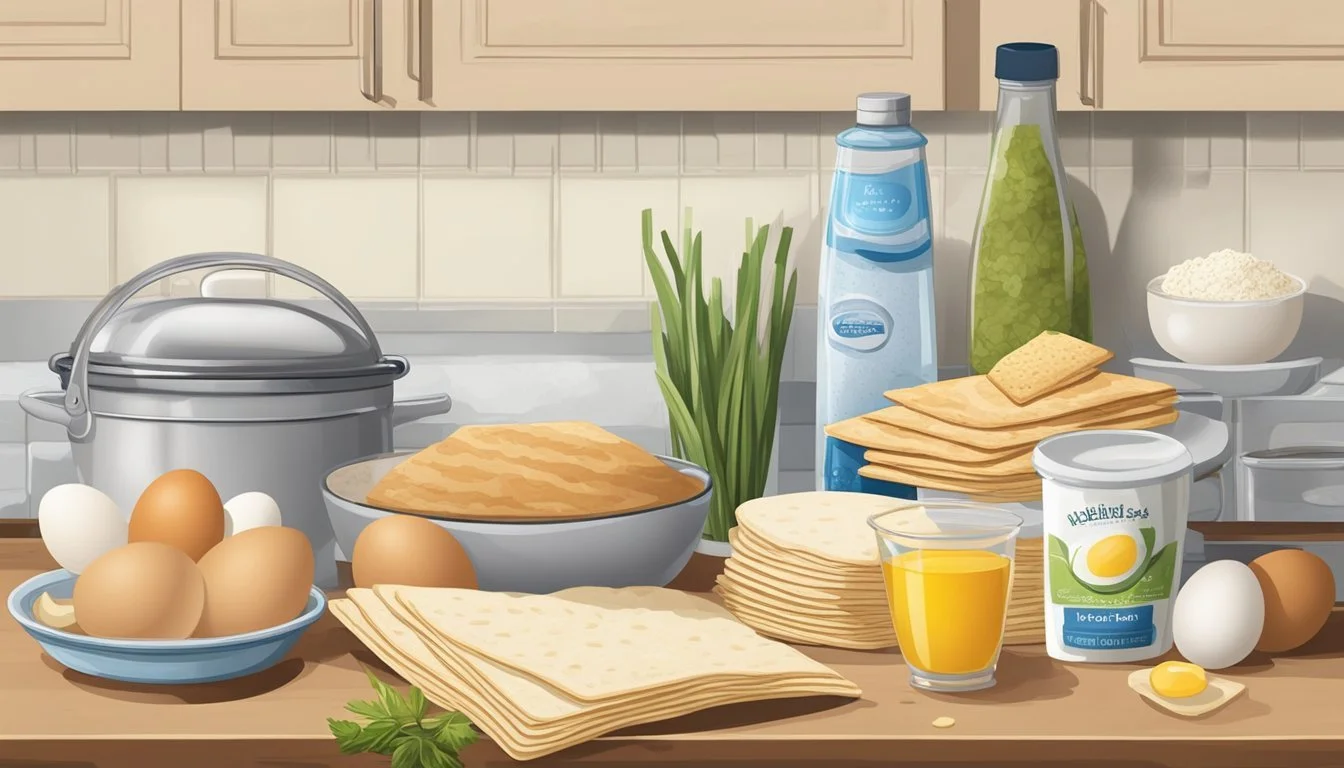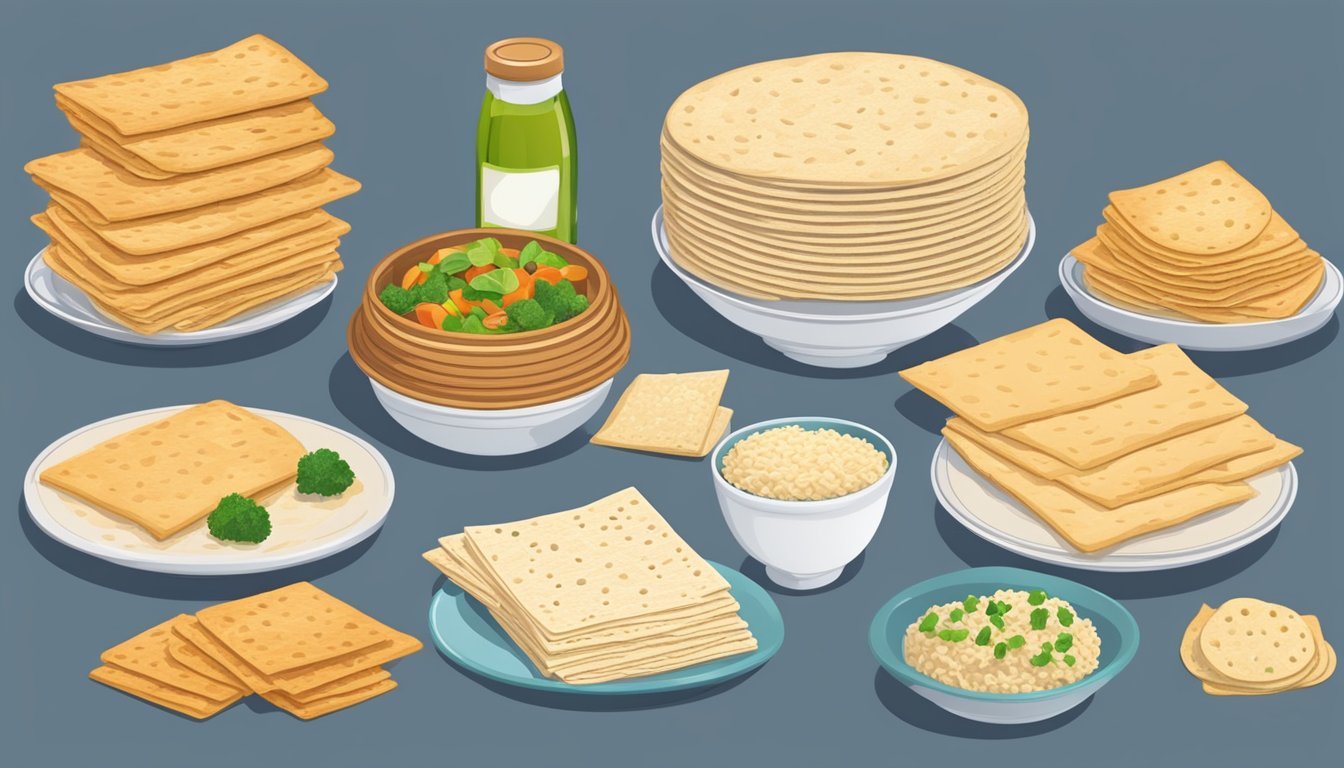Matzah Bread Substitutes
Alternatives for Passover and Beyond
During Passover, matzo bread holds great significance in Jewish cuisine. It is an unleavened bread traditionally eaten during the week-long festival, symbolizing the haste of the Jewish people's departure from Egypt, which did not allow time for their bread to rise. Matzo bread is more than a ritual food; it also serves as a versatile ingredient in several Passover dishes. However, there are instances where substitutes might be needed, either due to dietary restrictions or availability.
Finding appropriate substitutes for matzo bread is important to maintain the dietary laws of Passover while also allowing for variety in meal preparation. It's essential that any alternative should be unleavened, aligning with the kosher-for-Passover requirements. There are several options for substitution, such as almond meal and quinoa flour, both of which are free of leavening agents and thus retain the spirit of the Passover practices.
Even within the context of Passover observance, culinary creativity can flourish with these substitutions. While substitutes like breadcrumbs and saltine crackers are not suitable for Passover, they serve as handy alternatives outside the holiday's constraints. Such alternatives offer different flavors and textures, allowing for a broader range of recipes and applications in Jewish cuisine, as well as adaptations for those with specific dietary needs.
Understanding Matzo
Matzo, a crisp unleavened flatbread, is an integral component of Jewish cuisine and tradition. It is both a simple bread and a symbol of cultural heritage.
Role in Jewish Traditions
Matzo is famously associated with the Jewish holiday of Passover. During this eight-day festival, eating matzo is a commandment, symbolizing the haste with which the Israelites fled Egypt, leaving no time for their bread to rise. It is called the "bread of affliction," reminding them of the hardships of slavery.
Passover Use: Matzo is the centerpiece of the Seder meal.
Ritual Significance: It is eaten to fulfill the obligation of recounting Jewish liberation.
Matzo Composition
Traditionally, matzo consists of only two ingredients—flour and water. It must be baked within eighteen minutes from the time the water contacts the flour to avoid any fermentation, which would cause it to be considered leavened and thus inappropriate for Passover.
Ingredients: Plain flour and water.
Leaven: No yeast or other leavening agents are used.
Once baked, matzo can be ground into matzo meal, which serves as a versatile ingredient in a range of Jewish recipes, such as matzo balls and matzo brei. Matzo meal provides a texture suitable for Passover, where traditional leavening is not used.
Why Substitute Matzo?
Finding a suitable matzo substitute can be crucial due to dietary restrictions and issues concerning availability. Substitutes may vary in terms of texture and taste but aim to fulfill similar culinary roles.
Dietary Restrictions
Individuals with gluten intolerance or celiac disease require gluten-free options when substituting matzo, as traditional matzo is made from wheat. Options such as quinoa flour or almond meal are preferred as they cater to these dietary needs. During Passover, many turn to Kosher for Passover substitutes that exclude leavened grains, making alternatives such as matzo cake meal or specially processed Passover breadcrumbs essential.
Availability Concerns
Matzo meal may not always be readily available in supermarkets or a kosher store nearby, especially outside of Passover season. In more remote areas, or in places with smaller Jewish communities, one may struggle to find matzo meal on shelves. Turn to accessible ingredients like plain breadcrumbs or crushed crackers, provided that they meet individual dietary guidelines and are appropriate for the intended dish.
Making Matzo Alternatives
When seeking matzo meal substitutes for dishes, especially during Passover, it's important to consider both the texture and cultural or religious dietary restrictions involved.
Creating Substitutes
When creating matzo meal substitutes, one should mimic the dry, crumbly texture that matzo meal provides. Substitutes like almond meal and potato starch are suitable for Passover and offer a similar consistency. Quinoa flour has gained popularity as a kosher-for-Passover alternative, given that it is gluten-free and provides a neutral base for recipes. For those not restricted by Passover dietary laws, transforming common pantry items into substitutes is straightforward:
Breadcrumb and Panko crumbs: These can replace matzo meal on a one-to-one basis, suitable for coatings and bindings.
Plain crushed biscuits or Marie biscuits: Crushed finely, they make a decent filling and binding agent.
Soda crackers or Saltine crackers: When crushed, they are a quick alternative, barring Passover considerations.
Ingredients Comparable to Matzo
The table below lists comparable ingredients to matzo meal and their best uses:
Substitute Best Used For Passover Friendly Almond Meal Baked goods, coatings Yes Quinoa Flour Baked goods, general cooking Yes Breadcrumb Coatings, fillings No Panko Crumbs Coatings, textures in dishes No Potato Starch Binding, thickening Yes
It's important to use these alternatives with an understanding of the role matzo meal plays in recipes—primarily as a thickener, binder, or coating. For gatherings such as Passover, it is crucial to opt for ingredients like almond meal, quinoa flour, or potato starch that align with Passover's dietary restrictions.
Substitute Ingredients in Recipes
When preparing dishes that typically require matzo meal, such as matzo balls or kugel, finding an appropriate substitute is crucial to maintain the desired texture and taste. Specific substitutes can offer a different consistency or flavor profile, making them more suitable for certain recipes.
Bread Substitutes
For Moisture Absorption in Recipes Such as Meatloaf or Casseroles:
Plain Breadcrumbs: These are a versatile replacement and work well for binding ingredients together.
Panko Crumbs: A light, flaky option originating from Japan, ideal for creating a crispy coating on meats or vegetables.
Cracker Alternatives
For Matzo Brei or Matzah Brei, Where a Crisp Texture is Desired:
Soda Crackers: Crushed, they resemble the texture of matzo meal and adapt well to both sweet and savory dishes.
Saltine Crackers: Easily crushed and similar in flavor to matzo, saltines serve as an effective substitute outside of Passover.
Binding Agents
When Preparing Matzo Balls or for Use as a Binding Ingredient in Dishes like Meatballs or Crab Cakes:
Matzo Cake Meal: Finer than matzo meal and can help create a delicate texture.
Quinoa Flour: Gluten-free and sustains the structure of dishes, it is especially useful during Passover.
Almond Meal: Adds a nutty flavor and binds ingredients effectively, suitable for savory and sweet creations alike.
To ensure the integrity of your dish remains intact, it's important to consider the moisture content of your chosen substitute. Selected replacement ingredients might absorb liquid differently than matzo meal, potentially altering the finished product's moisture level.
Gluten-Free and Healthy Substitutes
For those observing dietary restrictions or allergic responses to gluten, matzah presents a unique challenge during Passover. The search for alternatives involves seeking out or crafting substitutes that both comply with the spirit of the holiday and cater to gluten-free needs.
Nutritional Alternatives
Substitutes for matzah must bring nutritional benefits to the table. Almond flour and coconut macaroons serve as excellent gluten-free, Passover-friendly options. Almond flour is rich in protein, fiber, and vitamins, providing a nourishing alternative that complements a range of dishes. Coconut macaroons offer a sweet, satisfying choice that's inherently gluten-free and can be effortlessly incorporated into festive meals.
Gluten-Free Choices
Moving beyond nutritional content, individuals require gluten-free options that truly mimic the role of matzah. One may consider using teff flour for a whole-grain, nutrient-dense substitute, while cornmeal can be fashioned into unleavened bread, maintaining the tradition. Additionally, potato pancakes, though thicker, could serve as hearty replacements. Quinoa flour also strikes a balance between tradition and dietary needs, ensuring everyone at the Seder can partake in a gluten-free, Passover-appropriate bread substitute.
Global Influence on Substitutes
The search for Matzah bread substitutes has been shaped significantly by regional culinary practices, particularly those from the Middle East and American cuisine. These influences have introduced a variety of flavors and textures to traditional Jewish dishes.
Middle Eastern Influence
In Middle Eastern cuisine, charoset plays a pivotal role during Passover. It represents the mortar used by the Israelites in Egypt, traditionally made from a mixture of apples, nuts, wine, and spices. However, every country has its twist, with some using dates and figs, which influence the taste and texture profile of the substitute used for Matzah.
Substitutes inspired by Middle Eastern cuisine often include:
Ground almonds or other nuts
Dates and figs reduced to a paste
Quinoa flour for a gluten-free option
Influence of American Cuisine
American cuisine's versatility and openness to innovation have led to the acceptance of various Matzah substitutes that cater to different tastes and dietary restrictions. In America, dishes like knishes and latkes are often adapted during Passover by substituting Matzah meal for the traditional dough or potato base.
Common American-inspired substitutes:
Plain breadcrumbs: used in recipes outside Passover
Crushed crackers: e.g., plain crushed biscuits or panko crumbs
Almond meal: a gluten-free and Passover-friendly option
Both Middle Eastern and American cuisines have left their mark on the substitutes used for Matzah, blending tradition with contemporary dietary trends and preferences.
Key Considerations When Choosing Substitutes
When selecting substitutes for matzah meal, it's important to consider how variations in texture, flavor, and intended use can affect the outcome of a dish.
Texture and Consistency
Substitutes for matzah meal should ideally mimic its fine yet crumbly texture. Unflavored crackers crushed to a fine consistency can serve as a suitable alternative in recipes. Plain breadcrumbs offer a similar granularity but might impart a slightly denser consistency due to their production process. For a coarser texture, Panko crumbs can be used, although they might not provide the compact binding that matzah meal typically offers.
Flavor Profile
The choice of substitute also depends on the desired flavor profile of the dish. Matzah meal has a neutral taste, so unsalted crackers or refined, sugar-free alternatives maintain this balance. In contrast, plain breadcrumbs or bread crumbs may bring additional yeast or toasting flavors into the recipe, which could be either complementary or unwelcome, depending on the culinary application.
Culinary Applications
Understanding the role of matzah meal in recipes is crucial. It often acts as a thickener in soups, a binding agent in patties, or a crunchy topping. For instance, to achieve a crunchy exterior on fried foods, a substitute with a dryer and denser consistency might be preferred, such as plain breadcrumbs. It is also essential to consider the end use regarding Passover observances for those who adhere to dietary restrictions during the holiday; in this case, alternatives like quinoa flour or almond meal could be more appropriate.
Conclusion
In summary, when traditional matzo meal is unavailable or a variation in texture or flavor is desired, one has several viable alternatives to consider. Notably, Passover imposes dietary restrictions which narrow the range of acceptable substitutes, prioritizing the use of options like quinoa flour and almond meal, both of which respect the culinary guidelines of the holiday.
The substitutes for matzo meal outlined can be categorized according to their suitability for Passover and their potential uses in Jewish recipes:
Substitute Passover-Suitable Culinary Uses Almond meal Yes Baking, Coating Quinoa flour Yes Baking, Binding Crushed saltines No Filling, Coating Panko crumbs No Filling, Coating Bread crumbs No Binding, Topping
While exploring matzo substitutes, one must not only consider the textural and flavor profile desired but also the nutritional considerations. Almond meal, for instance, may add a rich, nutty flavor and is a good source of protein and heart-healthy fats. Quinoa flour offers a gluten-free option filled with protein and fiber.
The use of non-traditional ingredients can infuse a sense of culinary creativity into time-honored dishes. Cooks can experiment with these alternatives to achieve unique tastes and textures while paying homage to traditional methods.
Ultimately, the selection of a matzo meal replacement hinges on personal taste preferences, nutritional needs, and adherence to Passover dietary laws. Using this guide, individuals can confidently navigate their choices to maintain tradition or innovate within their culinary practices.





